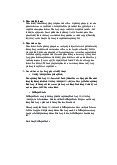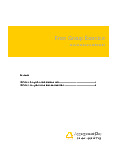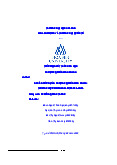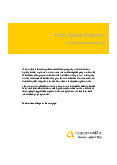



Preview text:
Company Case 6
Virgin America: Flight Service for the Tech Savvy
After an exceptionally frustrating day at the office, Jessica set out to unwind in one of her
favorite third places. The mood lighting immediately brought her blood pressure down as she walked in
and took a deep, relaxing breath. She was happy that her favorite spot was available—a comfy leather
chair in the back corner of the room, where she used the touchscreen at the table in front of her to order
her favorite drink. Then, putting on a set of noise-canceling headphones, Jessica began catching up on
her favorite TV show with her own personal entertain-ment portal.
If this sounds like a local Starbucks or trendy nightclub, think again. Jessica had just boarded a
flight on Virgin America, one of the youngest airlines in the United States. It’s also the hottest airline,
besting all competition in various industry and customer surveys. And after just six years in business,
Virgin America is also profitable—one of the fastest launch-to-profitability post-ings in all of airdom.
How does a start-up airline break into one of the most com-petitive industries in the world,
notorious for barriers to entry? For Virgin America, the answer is twofold—by putting custom-ers first
and by targeting the right customer segment.
Targeting the Right Customers
Virgin America first took to the skies in 2007. This wouldn’t be the first shot at starting an
airline for Richard Branson—founder of parent company Virgin Group. Virgin’s international airline,
Virgin Atlantic, had been crossing the pond between the United States and Europe since 1984. But
Virgin America would be an entirely independent enterprise. And while Branson and other Virgin
Group executives make no day-to-day decisions at Virgin America, the unorthodox Virgin culture—
fun, creative, even whacky—is unmistakable.
One of Branson’s core values that permeates Virgin America is this: Take care of your people
first and profits will follow. In an industry characterized by customer complaints about service, it
would seem that a customer-centric approach would be enough to gain a foothold in the market. But
when Virgin started air service in the United States, at least a few other airlines had already established
themselves based on a “customer first” man-tra, including industry leader Southwest Airlines. And
Virgin America knew that it could not expect to succeed by playing the low-price game. Not only was
Southwest the reigning champion on value, but the bulk of airline competitors were already beating
each other up for low-price dominance.
Virgin America found a different competitive hook. It targeted a segment of frequent fliers who
were young, savvy, influential, and willing to pay just a little bit more for an airline that would take
care of them—the Silicon Valley faction. By providing exceptional service and amenities that appeal to
this particular slice of airline customers, Virgin America has been able to charge slightly higher fares
and still establish a growing base of fiercely loyal patrons.
Honing In on the Details
Offering unique amenities in the airline business is a challenge for any company. But from the
beginning, the Virgin America experience was designed with its target customer in mind. Its fleet
consists of 53 Airbus A320s, each brand new when it went into service, minimizing the unexpected
delays due to mainte-nance and repairs. Custom-designed leather seats are roomier and more
comfortable than average coach seating. And that mood lighting? Not only does it bathe the aircraft
cabin in an appealing purplish glow, it automatically adjusts to one of 12 different shades based on outside light.
To appeal to tech gurus, Virgin America focused on equip-ping its planes with the latest
hardware and software. From day one, Virgin was the only domestic carrier to offer fleetwide in-flight
WiFi—a distinction that it maintains to this day, even as it has stayed ahead of the competition by
upgrading the network to ensure the fastest in-flight speeds available. Every seat has its own power
outlet, USB port, and nine-inch video touchscreen with a QWERTY keyboard/remote control.
That touchscreen provides access to the most advanced entertainment and information system in
U.S. skies. Virgin America’s proprietary Red system allows each guest to choose on-demand movies,
TV programs, music, or video games. Red also allows patrons to track their flight on interactive
Google Maps, engage in seat-to-seat chat with other customers, and order food and drinks for
themselves or anyone else on board. It’s a system designed to give passengers a feeling of control dur-
ing an experience that is otherwise mostly out of their control.
Many of these ideas came by way of Virgin America’s techy clientele. It’s no accident that the
company’s headquar-ters are located in Burlingame, California, just a few short miles from the San
Francisco airport. In fact, Virgin America is the only airline based in Silicon Valley. Not only is the
company constantly experimenting with every aspect of the business, it has made strong efforts to
involve Silicon Valley entrepreneurs and executives in the process, helping Virgin to think like its
disruptive clientele. “We see ourselves as more of an incubator,” says Luanne Calvert, Virgin America’s chief marketing officer.
Take VX Next, for example—a group of 30 or so frequent fliers who act as a brain trust for
Virgin America, generating ideas for the company at no charge. Among other winning ideas, this group
was instrumental in developing the company’s recent interactive promotional campaign. At the center
of the campaign is a slick cinematic site that provides viewers with a virtual tour of a Virgin America
flight. Demonstrating the air-line’s in-flight perks are founders and CEOs of companies such as
Pandora, Gilt, and Pitchfork. As part of the tour, visitors to the site discover that several of the
passengers on board are Vir-gin America frequent fliers and Silicon Valley celebrities who have made
creative contributions to the airline’s services with things such as curating in-flight music and menu items.
Virgin America’s home-brewed tech panel was also instru-mental in creating the company’s
latest safety video. When the company started operations, it delighted customers with a safety video
like none other—an animated short featuring a techie nun and a matador with his bull. Posted online as
well, the video racked up millions of views and cemented Virgin America’s image as a company that
could find creative alternatives to just about anything, even a federally mandated reminder to wear seat-
belts. That image has carried over to Virgin America’s new safety video—one created by a top
Hollywood director and world-class choreographers that features 10 So You Think You Can Dance
alums, two former Olympians, and one American Idol finalist. Debuting in Times Square and getting
plenty of coverage from the press, the new safety video racked up 6 million views in less than two weeks. Above the Clouds
Although there is plenty of anecdotal evidence that Virgin America’s customers are thrilled with
its service, it’s the indus-try quality ratings that count. Virgin America is coming through with flying
colors there as well. In the most recent annual Airline Quality Report—a survey that ranks airlines
based on mishandled baggage, customer complaints, denied boardings, and on-time percent—Virgin
America was number one. Vir-gin America is also in the top spot for customer satisfaction on
Consumer Reports. In fact, Virgin America came away with the highest score achieved by any U.S. airline in many years.
Not to get too cocky, Virgin knows that maintaining such high rankings will be a challenge. In
the coming years, the air-line will expand service to more cities with cold climates, a factor that will
increase the likelihood of canceled or delayed flights. It will also increase the number of passengers on
flights, which will lead to longer boarding and deplaning times, affecting multiple customer service
metrics. And with Vir-gin’s techy and connected clientele, any screwup is likely to be texted, Tweeted,
or otherwise broadcast for all the world to see. Playing the features and amenities game is also
problematic. Things that delight customers today become ho hum tomorrow, especially when
competitors are constantly trying to improve their offerings.
That’s why Virgin America views its operations as a work in progress, continually changing and
improving, no matter how good current operations are. “If we stand still, they’ll catch us,” says David
Cush, Virgin America’s CEO. And Virgin America sees all those Tweeting customers as an opportunity
to address customer service issues in real time, not to mention a powerful source of word of mouth.
With all its success, after six years, Virgin America still had not achieved an annual profit. With
still-skeptical experts look-ing on, however, the company has now crossed that threshold, posting net
profits for the past two years. For the most recent year, Virgin America achieved $84 million in profit—
the high-est ever for a young airline—on $1.5 billion in revenues. The company also went public in the
second-largest airline IPO in history. Although the company is far from being out of the woods, Virgin
America will continue to slowly expand its ser-vices by doing what it has done for its first eight years
—wow every customer with exceptional service while giving the tech community a little something
extra. It’s a formula that Virgin aims to keep applying, even after it grows up.
Questions for Discussion
1. Using the full spectrum of segmentation variables, describe how Virgin America segments and
targets the market for airline services.
2. Which market targeting strategy is Virgin America follow-ing? Justify your answer.
3. Write a positioning statement for Virgin America. 4.
Will Virgin America succeed in the long run? Why or why not?



